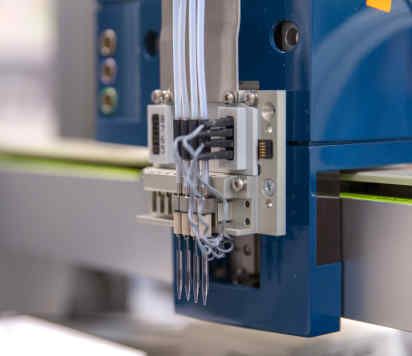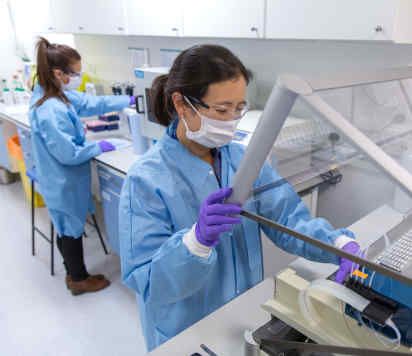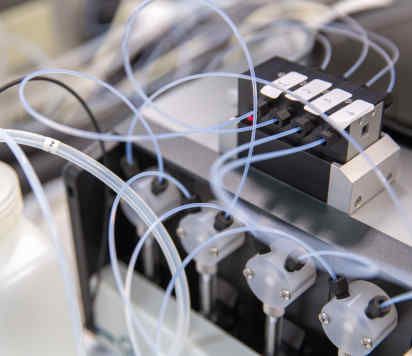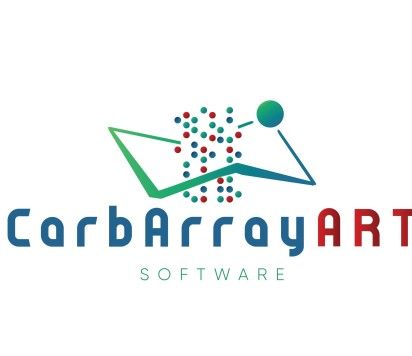Results
- Showing results for:
- Reset all filters
Search results
-
Journal articleCorreia VG, Trovao F, Pinheiro BA, et al., 2021,
Mapping molecular recognition of β1,3-1,4-glucans by a surface glycan-binding protein from the human gut symbiont Bacteroides ovatus
, Microbiology Spectrum, Vol: 9, ISSN: 2165-0497A multigene polysaccharide utilization locus (PUL) encoding enzymes and surface carbohydrate (glycan)-binding proteins (SGBPs) was recently identified in prominent members of Bacteroidetes in the human gut and characterized in Bacteroides ovatus. This PUL-encoded system specifically targets mixed-linkage β1,3-1,4-glucans, a group of diet-derived carbohydrates that promote a healthy microbiota and have potential as prebiotics. The BoSGBPMLG-A protein encoded by the BACOVA_2743 gene is a SusD-like protein that plays a key role in the PUL’s specificity and functionality. Here, we perform a detailed analysis of the molecular determinants underlying carbohydrate binding by BoSGBPMLG-A, combining carbohydrate microarray technology with quantitative affinity studies and a high-resolution X-ray crystallography structure of the complex of BoSGBPMLG-A with a β1,3-1,4-nonasaccharide. We demonstrate its unique binding specificity toward β1,3-1,4-gluco-oligosaccharides, with increasing binding affinities up to the octasaccharide and dependency on the number and position of β1,3 linkages. The interaction is defined by a 41-Å-long extended binding site that accommodates the oligosaccharide in a mode distinct from that of previously described bacterial β1,3-1,4-glucan-binding proteins. In addition to the shape complementarity mediated by CH-π interactions, a complex hydrogen bonding network complemented by a high number of key ordered water molecules establishes additional specific interactions with the oligosaccharide. These support the twisted conformation of the β-glucan backbone imposed by the β1,3 linkages and explain the dependency on the oligosaccharide chain length. We propose that the specificity of the PUL conferred by BoSGBPMLG-A to import long β1,3-1,4-glucan oligosaccharides to the bacterial periplasm allows Bacteroidetes to outcompete bacteria that lack this PUL for utilization of β1,3-1,4-glucans.
-
Journal articleGyapon-Quast F, Goicoechea de Jorge E, Malik T, et al., 2021,
Defining the glycosaminoglycan interactions of complement factor H-related protein 5
, Journal of Immunology, Vol: 207, Pages: 534-541, ISSN: 0022-1767Complement activation is an important mediator of kidney injury in glomerulonephritis. Complement factor H (FH) and FH-related protein 5 (FHR-5) influence complement activation in C3 glomerulopathy and IgA nephropathy by differentially regulating glomerular complement. FH is a negative regulator of complement C3 activation. Conversely, FHR-5 in vitro promotes C3 activation either directly or by competing with FH for binding to complement C3b. The FH-C3b interaction is enhanced by surface glycosaminoglycans (GAGs) and the FH-GAG interaction is well-characterized. In contrast, the contributions of carbohydrates to the interaction of FHR-5 and C3b are unknown. Using plate-based and microarray technologies we demonstrate that FHR-5 interacts with sulfated GAGs and that this interaction is influenced by the pattern and degree of GAG sulfation. The FHR-5-GAG interaction that we identified has functional relevance as we could show that the ability of FHR-5 to prevent binding of FH to surface C3b is enhanced by surface kidney heparan sulfate. Our findings are important in understanding the molecular basis of the binding of FHR-5 to glomerular complement and the role of FHR-5 in complement-mediated glomerular disease.
-
Journal articleBonnardel F, Haslam SM, Dell A, et al., 2021,
Proteome-wide prediction of bacterial carbohydrate-binding proteins as a tool for understanding commensal and pathogen colonisation of the vaginal microbiome
, npj Biofilms and Microbiomes, Vol: 7, Pages: 1-10, ISSN: 2055-5008Bacteria use carbohydrate-binding proteins (CBPs), such as lectins and carbohydrate-binding modules (CBMs), to anchor to specific sugars on host surfaces. CBPs in the gut microbiome are well studied, but their roles in the vagina microbiome and involvement in sexually transmitted infections, cervical cancer and preterm birth are largely unknown. We established a classification system for lectins and designed Hidden Markov Model (HMM) profiles for data mining of bacterial genomes, resulting in identification of >100,000 predicted bacterial lectins available at unilectin.eu/bacteria. Genome screening of 90 isolates from 21 vaginal bacterial species shows that those associated with infection and inflammation produce a larger CBPs repertoire, thus enabling them to potentially bind a wider array of glycans in the vagina. Both the number of predicted bacterial CBPs and their specificities correlated with pathogenicity. This study provides new insights into potential mechanisms of colonisation by commensals and potential pathogens of the reproductive tract that underpin health and disease states.
-
Journal articleMcAllister N, Liu Y, Silva LM, et al., 2020,
Chikungunya virus strains from each genetic clade bind sulfated glycosaminoglycans as attachment factors
, Journal of Virology, Vol: 94, ISSN: 0022-538XChikungunya virus (CHIKV) is an arthritogenic alphavirus that causes debilitating musculoskeletal disease. CHIKV displays broad cell, tissue, and species tropism, which may correlate with the attachment factors and entry receptors used by the virus. Cell-surface glycosaminoglycans (GAGs) have been identified as CHIKV attachment factors. However, the specific types of GAGs and potentially other glycans to which CHIKV binds and whether there are strain-specific differences in GAG binding is not fully understood. To identify the types of glycans bound by CHIKV, we conducted glycan microarray analyses and discovered that CHIKV preferentially binds GAGs. Microarray results also indicate that sulfate groups on GAGs are essential for CHIKV binding and that CHIKV binds most strongly to longer GAG chains of heparin and heparan sulfate. To determine whether GAG-binding capacity varies among CHIKV strains, a representative strain from each genetic clade was tested. While all strains directly bound to heparin and chondroitin sulfate in ELISAs and depended on heparan sulfate for efficient cell-binding and infection, we observed some variation by strain. Enzymatic removal of cell-surface GAGs and genetic ablation that diminishes GAG expression reduced CHIKV binding and infectivity of all strains. Collectively, these data demonstrate that GAGs are the preferred glycan bound by CHIKV, enhance our understanding of the specific GAG moieties required for CHIKV binding, define strain differences in GAG engagement, and provide further evidence for a critical function of GAGs in CHIKV cell attachment and infection.IMPORTANCE Alphavirus infections are a global health threat, contributing to outbreaks of disease in many parts of the world. Recent epidemics caused by CHIKV, an arthritogenic alphavirus, resulted in more than 8.5 million cases as the virus has spread into new geographic regions, including the Western Hemisphere. CHIKV causes disease in the majority of people infected, leading
-
Journal articleYork WS, Mazumder R, Ranzinger R, et al., 2020,
GlyGen: Computational and Informatics Resources for Glycoscience
, GLYCOBIOLOGY, Vol: 30, Pages: 72-73, ISSN: 0959-6658- Author Web Link
- Cite
- Citations: 82
-
Journal articleVendele I, Willment JA, Silva LM, et al., 2020,
Mannan detecting C-type lectin receptor probes recognise immune epitopes with diverse chemical, spatial and phylogenetic heterogeneity in fungal cell walls
, PLoS Pathogens, Vol: 16, Pages: 1-29, ISSN: 1553-7366During the course of fungal infection, pathogen recognition by the innate immune system is critical to initiate efficient protective immune responses. The primary event that triggers immune responses is the binding of Pattern Recognition Receptors (PRRs), which are expressed at the surface of host immune cells, to Pathogen-Associated Molecular Patterns (PAMPs) located predominantly in the fungal cell wall. Most fungi have mannosylated PAMPs in their cell walls and these are recognized by a range of C-type lectin receptors (CTLs). However, the precise spatial distribution of the ligands that induce immune responses within the cell walls of fungi are not well defined. We used recombinant IgG Fc-CTLs fusions of three murine mannan detecting CTLs, including dectin-2, the mannose receptor (MR) carbohydrate recognition domains (CRDs) 4–7 (CRD4-7), and human DC-SIGN (hDC-SIGN) and of the β-1,3 glucan-binding lectin dectin-1 to map PRR ligands in the fungal cell wall of fungi grown in vitro in rich and minimal media. We show that epitopes of mannan-specific CTL receptors can be clustered or diffuse, superficial or buried in the inner cell wall. We demonstrate that PRR ligands do not correlate well with phylogenetic relationships between fungi, and that Fc-lectin binding discriminated between mannosides expressed on different cell morphologies of the same fungus. We also demonstrate CTL epitope differentiation during different phases of the growth cycle of Candida albicans and that MR and DC-SIGN labelled outer chain N-mannans whilst dectin-2 labelled core N-mannans displayed deeper in the cell wall. These immune receptor maps of fungal walls of in vitro grown cells therefore reveal remarkable spatial, temporal and chemical diversity, indicating that the triggering of immune recognition events originates from multiple physical origins at the fungal cell surface.
-
Journal articleAzevedo HS, Braunschweig AB, Chiechi RC, et al., 2019,
New directions in surface functionalization and characterization: general discussion.
, Faraday Discuss, Vol: 219, Pages: 252-261 -
Journal articleTen F, 2019,
Nanolithography of biointerfaces
, FARADAY DISCUSSIONS, Vol: 219, Pages: 262-275, ISSN: 1359-6640 -
Journal articleWu N, Silva LM, Liu Y, et al., 2019,
Glycan Markers of Human Stem Cells Assigned with Beam Search Arrays.
, Mol Cell Proteomics, Vol: 18, Pages: 1981-2002, ISSN: 1535-9476Glycan antigens recognized by monoclonal antibodies have served as stem cell markers. To understand regulation of their biosynthesis and their roles in stem cell behavior precise assignments are required. We have applied state-of-the-art glycan array technologies to compare the glycans bound by five antibodies that recognize carbohydrates on human stem cells. These are: FC10.2, TRA-1-60, TRA-1-81, anti-i and R-10G. Microarray analyses with a panel of sequence-defined glycans corroborate that FC10.2, TRA-1-60, TRA-1-81 recognize the type 1-(Galβ-3GlcNAc)-terminating backbone sequence, Galβ-3GlcNAcβ-3Galβ-4GlcNAcβ-3Galβ-4GlcNAc, and anti-i, the type 2-(Galβ-4GlcNAc) analog, Galβ-4GlcNAcβ-3Galβ-4GlcNAcβ-3Galβ-4GlcNAc, and we determine substituents they can accommodate. They differ from R-10G, which requires sulfate. By Beam Search approach, starting with an antigen-positive keratan sulfate polysaccharide, followed by targeted iterative microarray analyses of glycan populations released with keratanases and mass spectrometric monitoring, R-10G is assigned as a mono-sulfated type 2 chain with 6-sulfation at the penultimate N-acetylglucosamine, Galβ-4GlcNAc(6S)β-3Galβ-4GlcNAcβ-3Galβ-4GlcNAc. Microarray analyses using newly synthesized glycans corroborate the assignment of this unique determinant raising questions regarding involvement as a ligand in the stem cell niche.
-
Journal articleWells L, Feizi T, 2019,
Editorial overview: Carbohydrates: <i>O</i>-glycosylation
, CURRENT OPINION IN STRUCTURAL BIOLOGY, Vol: 56, Pages: III-V, ISSN: 0959-440X- Author Web Link
- Cite
- Citations: 2
This data is extracted from the Web of Science and reproduced under a licence from Thomson Reuters. You may not copy or re-distribute this data in whole or in part without the written consent of the Science business of Thomson Reuters.
General enquiries
Carbohydrate microarray analyses
Professor Ten Feizi
t.feizi@imperial.ac.uk
+44 (0) 20 7594 7207
Dr Yan Liu
yan.liu2@imperial.ac.uk
+44 (0) 20 7594 2598
Dr Antonio Di Maio
a.di-maio@imperial.ac.uk
Carbohydrate structural analyses
Dr Wengang Chai
w.chai@imperial.ac.uk
+44 (0) 20 7594 2596





